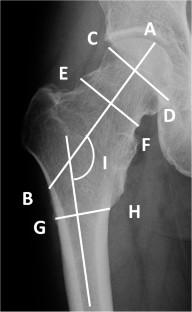Indian Journal of Orthopaedics ( IF 1 ) Pub Date : 2022-07-28 , DOI: 10.1007/s43465-022-00681-w Kazu Matsumoto 1, 2 , Hiroyasu Ogawa 1, 3 , Shingo Komura 1 , Haruhiko Akiyama 1

|
Objective
In this study, we focused on the hip joints and examined pain and functional impairment, and their relationship with anatomical characteristics in MHE patients.
Methods
Patients with MHE followed up in our hospital from January 2020 to December 2020 were enrolled. Clinical hip functional outcomes were evaluated using the Japanese Orthopedic Association (JOA) hip score and hip range of motion (ROM). Proximal femur geometric measurements were evaluated using radiography.
Results
A total of 39 patients (78 hips) with a median age of 25.6 years and average JOA score of 94.0 ± 10.5 were included. Eight patients felt pain in their hip joints. The average ROM score was 18.2 ± 2.5, and 47.4% of the patients with MHE had ROM limitation. The average score of ability to walk was 19.6 ± 1.8, and three patients had some problems with walking. The average ADL score was 18.2 ± 2.5, and 51.3% of patients with MHE had some failures in ADL. The hip flexion and internal rotation were markedly restricted compared with the normal values. When patients were grouped according to their ADL scores, we found that the ADL failure group had a significantly lower ROM score than the no ADL failure group (p < 0.0001), and there were significant differences between the groups in terms of femoral neck widening (p = 0.0001).
Conclusions
We found that half of MHE patients had some failures in their ADL due to hip functional impairment. The study results also suggest that femoral neck widening affected ADL failure and ROM limitation.
中文翻译:

多发性遗传性外生骨疣患者髋关节功能损伤及日常生活活动能力下降
客观的
在这项研究中,我们重点关注髋关节,检查 MHE 患者的疼痛和功能障碍及其与解剖特征的关系。
方法
纳入2020年1月至2020年12月在我院随访的MHE患者。使用日本骨科协会 (JOA) 髋关节评分和髋关节活动范围 (ROM) 评估临床髋关节功能结果。使用放射线照相术评估近端股骨几何测量。
结果
共有 39 名患者(78 髋),中位年龄为 25.6 岁,平均 JOA 评分为 94.0 ± 10.5。八名患者感到髋关节疼痛。平均 ROM 评分为 18.2 ± 2.5,47.4% 的 MHE 患者存在 ROM 受限。步行能力平均得分为19.6±1.8,其中3例患者存在一定的步行问题。平均 ADL 评分为 18.2 ± 2.5,51.3% 的 MHE 患者 ADL 出现一定程度的失败。与正常值相比,髋关节屈曲和内旋明显受限。当根据 ADL 评分对患者进行分组时,我们发现 ADL 失败组的 ROM 评分显着低于 ADL 未失败组(p < 0.0001),并且各组之间在股骨颈增宽方面存在显着差异(p = 0.0001)。
结论
我们发现一半的 MHE 患者由于髋关节功能障碍而出现日常生活活动障碍。研究结果还表明,股骨颈加宽会影响 ADL 衰竭和 ROM 限制。



























 京公网安备 11010802027423号
京公网安备 11010802027423号